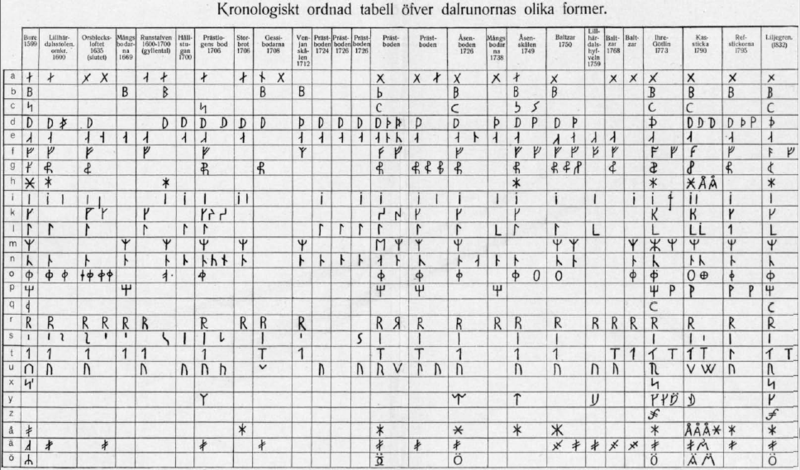
Dalecarlian runes
Encyclopedia

Dalarna
', English exonym: Dalecarlia, is a historical province or landskap in central Sweden. Another English language form established in literature is the Dales. Places involving the element Dalecarlia exist in the United States....
until the 20th century. The province has consequently been called the "last stronghold of the Germanic script".
When Carl Linnaeus visited Älvdalen
Älvdalen
Älvdalen is a locality and the seat of Älvdalen Municipality in Dalarna County, Sweden, with 1,812 inhabitants in 2005....
in Dalarna in 1734, he made the following note in his diary:
The Dalecarlian runes were derived from the medieval runes
Medieval runes
The medieval runes, or the futhork, was a Scandinavian 27 letter runic alphabet that evolved from the Younger Futhark after the introduction of dotted runes at the end of the Viking Age and it was fully formed in the early 13th century...
, but the runic letters were combined with Latin ones, and Latin letters would progressively replace the runes. At the end of the 16th century, the Dalecarlian runic inventory was almost exclusively runic, but during the following centuries more and more individual runes were replaced with Latin characters. In its last stage almost every rune had been replaced with a Latin letter, or with special versions that were influenced by Latin characters.
Although the use of runes in Dalarna is an ancient tradition, the oldest dated inscription is from the last years of the 16th century. It is a bowl from the village of Åsen which says "Anders has made (this) bowl anno 1596". Scholars have registered more than 200 Dalecarlian runic inscriptions, mostly on wood, and they can be seen on furniture, bridal boxes, on the buildings of shieling
Shieling
A shieling is a small house or hut once common in the hills and mountains of Scotland and northern England. Farmers and their families lived there during the summer, when their livestock were grazing common land in the hills...
s, kitchen blocks, bowls, measuring sticks, etc. Most inscriptions are brief but there are also longer inscriptions.
The Dalecarlian runes remained in some use up to the 20th century. Some discussion remains on whether their use was an unbroken tradition throughout this period or whether people in the 19th and 20th centuries learned runes from books written on the subject. The character inventory was mainly used for transcribing Elfdalian.
Table
The following image, published in the scholarly periodical FornvännenFornvännen
Fornvännen is a Swedish academic journal in the fields of archaeology and Medieval art. It is published quarterly by the Royal Swedish Academy of Letters in Stockholm, Sweden. The journal's contributions are written in the Scandinavian languages, English, or German with summaries in English...
in 1906, presents the evolution of the Dalecarlian runes from the earliest attested ones in the late 16th century until a version from 1832:


